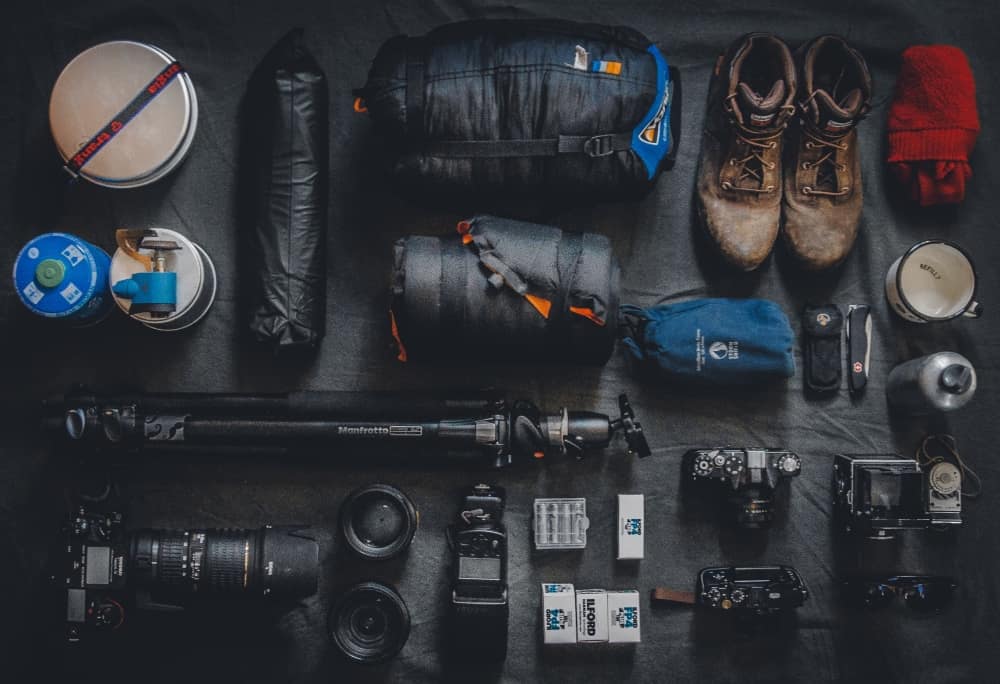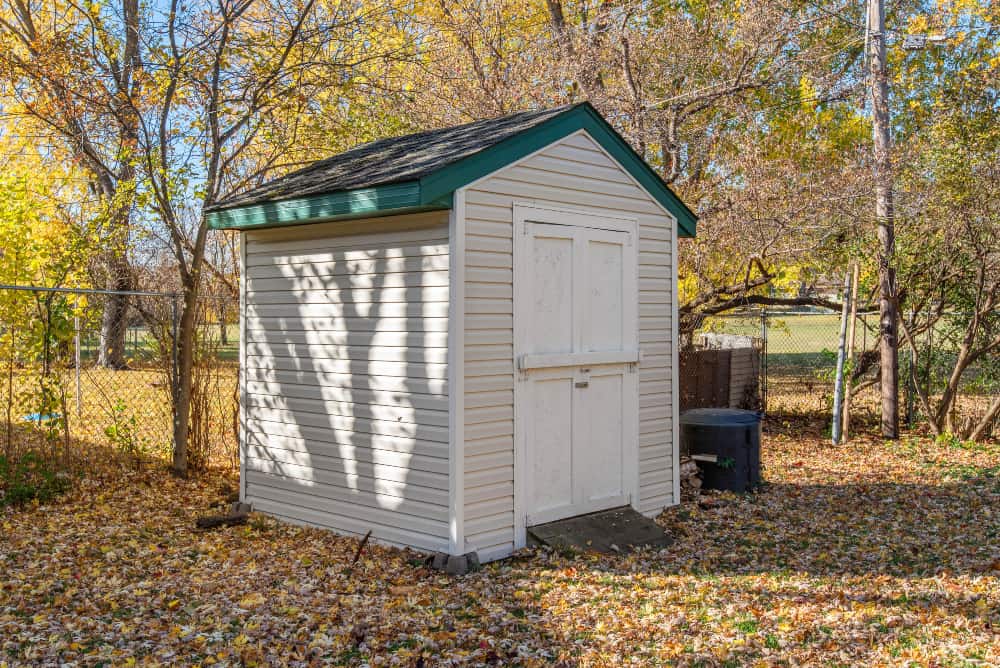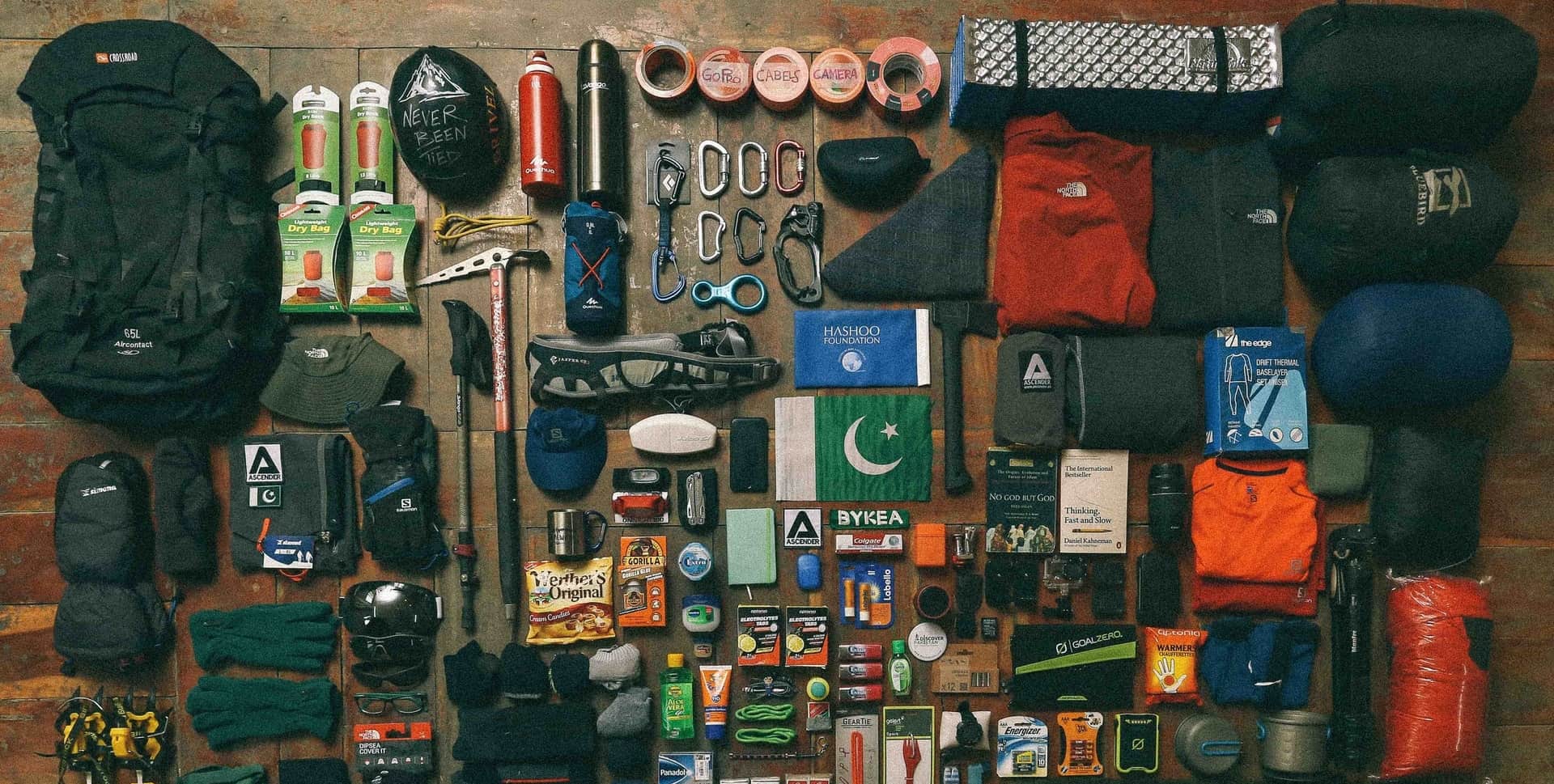Upon returning home from a tiring camping trip, it’s tempting to leave your gear in your backpack and deal with proper storage at a later time.
However, leaving your equipment in your pack for more than a day isn’t a good idea. You’re not only risking rust, mold, and damage; you’re also potentially housing creepy critters in your bag.
To avoid this, we’ve written a comprehensive guide on how to store camping gear in the most efficient way possible.
So if you’re wondering how to organize camping gear, let’s dive right in!
Related: Looking for a huge camping tent that can handle the whole family with room to breathe? Check our reviews of camping tents for families.
Prepare Your Camping Gear for Storage
Before storing camping gear away, follow these important tips:
Clean the Equipment and Remove Any Mold
Always clean your camping gear before putting them into storage. Doing so will eliminate foul odors and bacteria and ensure your equipment is ready to use the next time you go out camping.
Remove caked-on mud with a soft-bristled brush and spot clean with a damp sponge. Water and a bit of elbow grease should be enough to clean most of your camping gear, but you can also use natural cleaners if required.
As much as possible, avoid chemical detergents like bleach and all-purpose cleaners as they can damage the surface of your equipment.
While cleaning your gear, remove any signs of mold and/or bacteria. If you leave the mold as-is, you’re risking growth and infestation.
The easiest way to remove mold from camping equipment is with vinegar. When it comes to killing mold, vinegar is just as effective as bleach. For best results, use full-strength white distilled vinegar with 5 to 6% acidity.
Here’s how to clean mold with vinegar:
- Pour the vinegar into a spray bottle and generously spray the affected area.
- Let the vinegar sit for at least an hour.
- For stubborn mold, scrub the area with a brush or scouring pad. Otherwise, simply wipe it away with a paper towel or soft cloth.
- To avoid re-infection, rinse the item with warm water, then spray again with vinegar.
- Let the equipment fully dry before storing away.
Due to the vinegar’s acidic content, it may damage some surfaces. Thus, don’t use vinegar to clean mold from waxed wood, aluminum, or cast iron. For these surfaces, you may want to use a gentle commercial mold remover.
Ensure the Gear Is Fully Dry Before Putting It Away
Once you’ve cleaned your equipment, let them air dry for at least three hours so they’re fully dry for storage.
If you put them in storage still dripping wet or damp, they’ll develop mildew and generate unwanted odor. When you use them on your next camping trip, they’ll be all flaky, tacky, and smelly. That’s definitely something you don’t want.

Organize the Gear
Although tempting, don’t just randomly store your camping gear into whatever available space you have.
Instead, store them in plastic bins, heavy-duty plastic totes, or hanging shoe organizers. Make sure to label them so it won’t take hours to find a specific piece of equipment.
Lay your gear out and segregate them into piles of similar-purpose items.
Get rid of what you don’t need or use and make space for the more important items. Place your hiking gear in one pile, your skiing gear in another, etc.
Store light items like oars and ski poles in laundry hampers or similarly tall baskets.
If you have a ton of camping gear, list down or keep an inventory of what you’ve stored, especially if you have a ton of camping gear.
Choose the Right Place to Store Your Equipment
Whether it be your garage, storage unit, shed, or basement, designate a single storage space for all your camping gear.
This way, you won’t have to search for a certain item in five different places or rifle through box after box when packing for your next camping trip.
Also, store your camping gear in a safe and dry environment. Water, humidity, and excessive sunlight can damage certain tools and equipment, so double-check the area and ensure your items aren’t exposed to moisture or sunlight.
Clean the Storage Space and Put Away the Gear
Regardless of where you’re storing your gear, make sure the area is free of clutter, dust, dirt, and mold build-up.
Wipe dust build-up from harder-to-reach cubbies and shelves, as well as boxes, bins, drawers, or racks.
Sweep the floor and use a broom to remove spider webs and dust composites from the ceiling.
Scrub mold away with a sponge dipped in vinegar or diluted bleach.
If you’re storing your camping gear in an outdoor storage area, consider cleaning it with a pressure washer or a hose.

Choosing the Right Storage Space
If you’re not quite sure where to store your items, consider the following areas:
Garage or Basement
The garage and basement are among the best places to store camping items since they’re mostly out of the way.
If you’re planning to store your camping gear in your garage, install a few shelves and make use of storage bins to prevent clutter. This is especially true if you’re using your garage to store your car and other equipment.
The basement is dark, cool, and roomy, making it the ideal spot for storing certain camping equipment.
But since basements are susceptible to flooding and unwanted pests, don’t store your items unprotected. Store your camping gear in baskets, airtight bins, and built-in cabinets and shelves.
For basements with humid conditions, regularly run a dehumidifier to remove moisture from the air. Moisture invites mildew, rust, and mold, all of which can cause damage to camping equipment.
Apartment or Closet
If you don’t have enough space in your garage or basement or live in an apartment without either, store your camping gear in a closet or certain areas in your home.
To maximize your closet storage, invest in wall racks, shelves, and pegboards.
Use command hooks and hanging rods for your hats, sleeping bags, and trekking poles.
For smaller items, use see-through plastic bins.
Make sure to organize all your items by activity so you won’t have to rifle through multiple boxes to find a certain item.
If you don’t have space in your closet, store your camping items in your kitchen bedroom or living room drawers. You can also display your gear and turn them into decor or tuck them away neatly in a corner.

A Shed
Like the garage and basement, the shed is another out-of-the-way storage solution for your camping gear.
Sheds generally house gardening, landscaping, and home improvement items, so it’s often cluttered.
To keep your camping gear organized, install floating and/or adjustable shelves, free-standing metal shelving, and tool hangers for long-handed camping gear.
You can also use repurposed bookshelves and utility hooks.
Before storing your camping equipment in your shed, though, there are two factors you must consider: temperature and moisture.
Therefore, consider adding some insulation and damp proofing to the shed. Insulation consistently regulates your shed’s temperature, so it’s either too hot or too cold. Waterproofing prevents moisture-related damage to your camping gear.
Storage Ideas for Equipment
Here are some smart storage ideas for your camping equipment:
Use Clear Storage Bins
Storage bins are a camper’s best friend.
They keep camping equipment organized and ready to use no matter the time.
Since they’re see-through, you can see most if not all the contents within.
To keep things even more organized, label the bins accordingly. This way, you’ll have quick access to whatever you need without looking through a ton of other bins.
You can store these bins on shelves or stack them on top of each other.
Utilize Drawer Space
If you’re storing your equipment in the basement, garage, or closet, you likely already have drawer spaces.
Use these spaces to store small and frequently-used camping equipment, such as flashlights, electronics, and the like.
Throw out all the unused items and make space for your camping gear. Then, divide the drawer into labeled cubbies or create mini-compartments with a cardboard bottle divider.
If you don’t have a drawer, it’s worth investing in one. It looks much cleaner and more organized than storage bins, which is a plus for individuals who prefer keeping things neat and tidy.
Keep Smaller Items on a Pegboard
For many people, pegboards aren’t particularly aesthetically pleasing.
However, they do serve an important function: they put your camping tools and supplies in an easy-to-reach location.
Pegboards are especially useful for cluttered or small storage areas, as they allow you to hang all kinds of equipment out of the way.
Don’t Forget the Shelves
Shelves not only organize your camping gear but also provide ample space to store items in their appropriate location. They likewise raise your items off the ground, reducing the risk of water damage.
Shelving units come in numerous types, including fixed shelves, corner shelves, adjustable shelves, pull-out shelves, and floating shelves. Each type has its own unique function. Choose the right shelf for your space to maximize your storage unit.
Hanging Racks in Wardrobes
Hanging racks are perfect additions to small storage spaces. You can use them to hang your camping apparel, sleeping bags, and other camping equipment.
If you’re short on floor space, hang the rack on the ceiling to create an overhead storage space.
Use the Room in Your Backpack
If you’re regularly backpacking and car camping, store your frequently-used camping items in a backpack. This way, you can just grab the backpack anytime without having to re-organize your items for your trip.
Keep Extra Stuff in a Laundry Basket
Because it’s so spacious, a laundry basket is a fantastic storage solution for large and/or less-used camping items.
If you have multiple laundry baskets, stack them on top of each other or place them in cabinets or drawers to save some floor space.
Camping Gear Wall
If you have a bit of time on your hands, it’s worth installing a dedicated camping gear wall into your storage space. Use this wall to hang your ropes, bags, shoes, lanterns, and other camping gear.
How to Store Specific Camping Gear – Extra Hacks
Some equipment should be stored a little better than others to avoid damage. Here are some tips on how to store specific camping gear:
Storing Tents
For long-term storage, don’t leave your tent in the bag it came with. Instead, store it in an old pillowcase or similarly sized mesh bag to keep it loose and breathable.
Avoid hot, damp locations like the attic, basement, or car truck. If possible, store your tent in a gear closet or garage.
Keeping Camping Chairs Safe
Camping chairs are fairly easy to store because they fold up in a nice and compact manner. Cover the chairs with a cloth or tarp to keep them safe from dust and debris.
Bags and Backpacks
Keep your camping bags and backpacks in an easy-to-reach area. Place them on hooks, a nearby shelf, or close to the door. Make sure they’re easy to grab whenever you’re leaving the house or packing up for your next trip.
Clothes
Your camping clothes should be hung or neatly folded in a zippered compression bag. Make sure to launder them before packing them away so they’re ready to use on your next trip.
Camping Kitchen
Store your camp kitchen equipment in a chuck box, a large plastic bin, or a zippered bag made of tough fabric. Keep your utensils (spoons, forks, knives, etc.) in their own storage box. The same is said for items such as matches, butane lighters, and must-have spices.
Sleeping Bags
Store your sleeping bag in a large breathable cotton or mesh sack. If you leave the sleeping back in its original sack, it’ll lose its resiliency and plushness due to months of compression.
You can also hang them on a pegboard or in your closet.
Tarps
Tarps are quite resilient, so you can store them just about anywhere. After folding your tarps, place them on top of a shelf, a laundry basket, or a plastic bin.
Conclusion
There you have it, folks; our guide on how to store camping gear of every type!
Properly storing your camping gear takes a bit of time and organization at first, but it’s 100% worth the effort.
By taking the time to unpack, dry, and store your camping equipment, you’re improving their longevity and service life.
Next up: A first aid kit is an essential if you’re heading out camping – but what should be in it? Find out in our camping first aid kit packing list.
